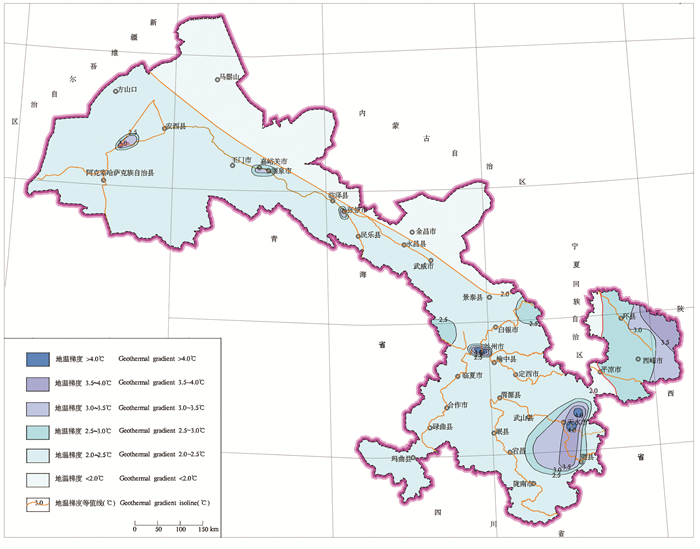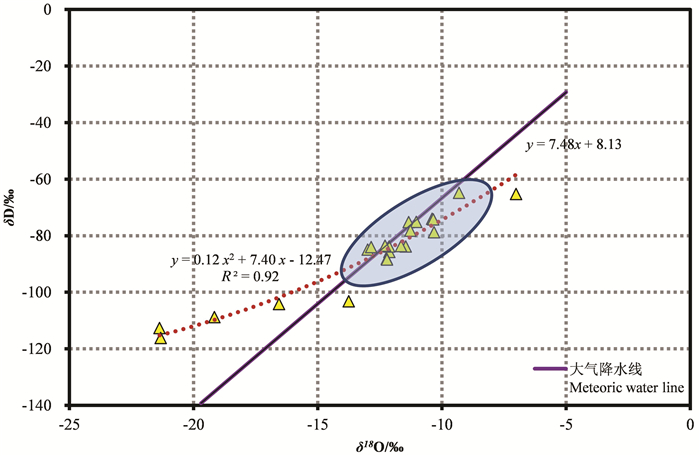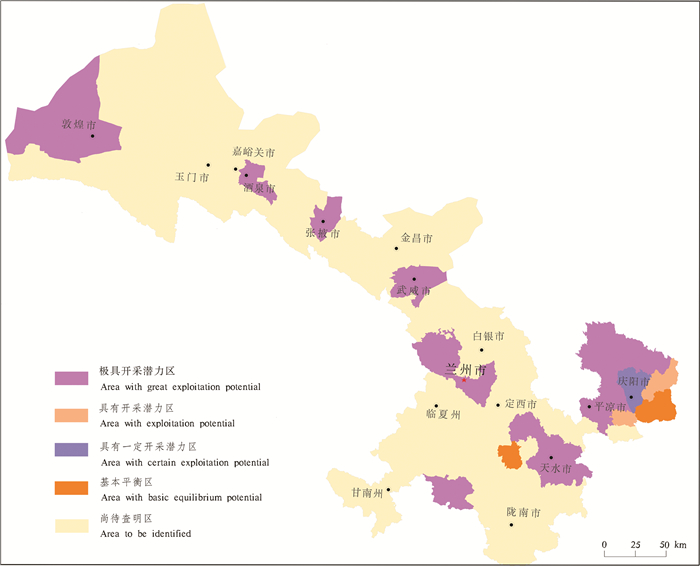Occurrence features of geothermal resources and geothermal potential assessment in Gansu Province
-
摘要:
甘肃省地热资源丰富,其地热资源的开发利用具有较大的潜力。本文介绍了甘肃省地热资源分布概况,结合地区构造、地热水化学特征、地热资源量及开发利用现状探讨了甘肃隆起山地对流型与沉积盆地传导型地热资源的赋存特征,并对两种类型地热资源潜力进行了分析评价。结果表明,沉积盆地地热资源分布于河西、陇西及陇东盆地等,热储类型为裂隙型和孔隙型,热储层自元古宙至新生代均有发育,岩性以砂岩为主;隆起山地型地热资源主要分布于祁连山和西秦岭造山带,热储类型为断裂破碎带,岩性以花岗岩为主;通过潜力计算得知,全省热量开采系数≥0.4的仅占29.17%,表明目前甘肃地热资源开采程度较低,开采潜力较大。
Abstract:Gansu Province possesses rich geothermal resources,and the potential for geothermal resources development and utilization is great. In this paper,the distribution of geothermal resources in Gansu was presented,In combination with the regional geological structure,the chemical characteristics of geothermal water,and the current situation of development and utilization of geothermal resources,the authors investigated the occurrence characteristics of geothermal resources of sedimentation basin conduction type and apophysis mountain convective type,and estimated the potential of the two types of geothermal resources. The results show that sedimentation basin geothermal resources are distributed in Hexi,Longxi and Longdong basins,the thermal reservoirs are of pore-type and fissure-type,thermal reservoirs were developed from Proterozoic to Cenozoic,and the reservoirs are dominated by sandstone; the apophysis mountain geothermal resources are mainly distributed in Qilian Mountain and western Qinling orogenic belt,the thermal reservoir type is of fault ruptured zone,and the lithology mostly is granite. From the potential calculation of geothermal resource,the proportion of heat recovery coefficient of greater than 0.4 is simply 29.16% in Gansu,indicating that the geothermal resources in Gansu are in a low mining degree,and hence has great mining potential.
-

-
表 1 甘肃省地热流体水化学成分
Table 1. Water chemical compositions of geothermal waters in Gansu Province
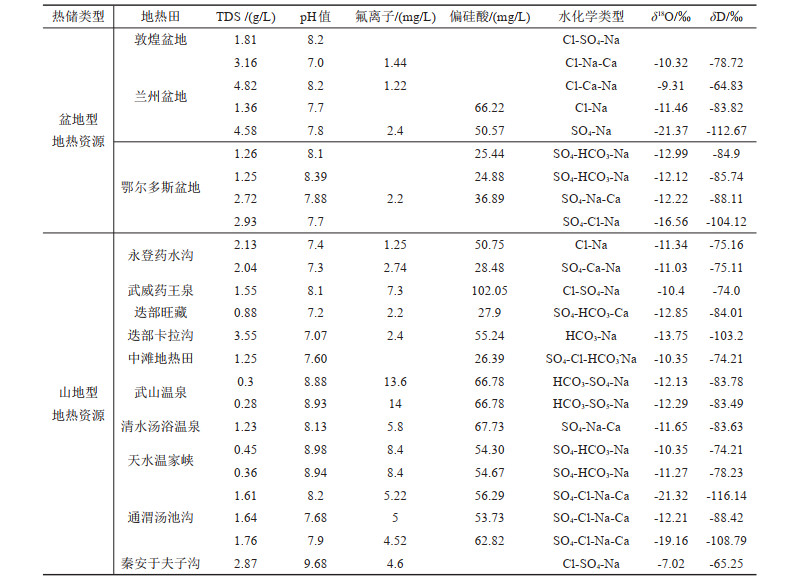
表 2 甘肃省地热流体热量潜力模数计算
Table 2. calculation of potential modulus of geothermal waters in Gansu Province
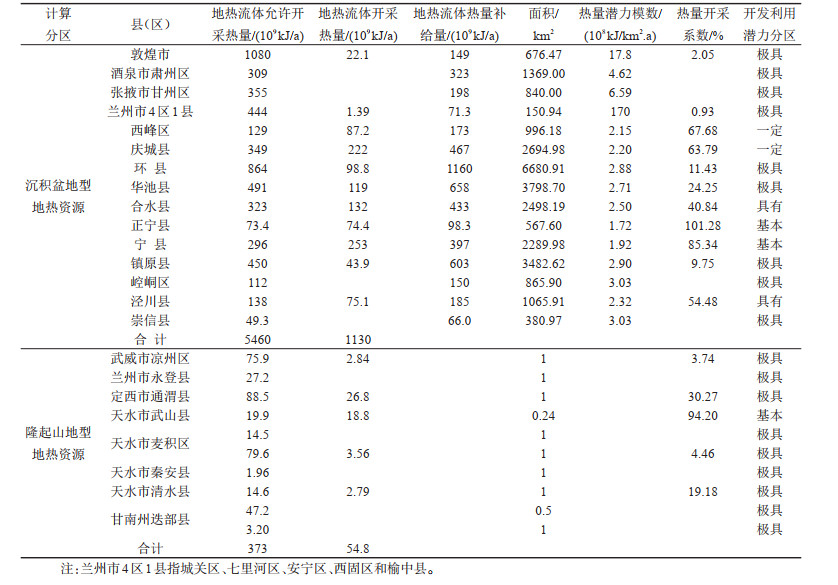
表 3 热量开采系数分区
Table 3. Division table of heat recovery coefficient
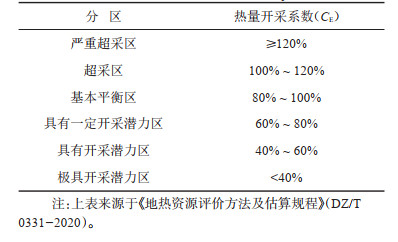
-
An Yongkang, Sun Zhixin, Li Baixiang. 2005. Distribution and exploitation of geothermal resources in Gansu province[J]. Gansu Geology, 14 (2):70-75(in Chinese with English abstract).
Bai Fu, Ma Genxi. 2005. Analysis of the occurrence of the geothermal resources in Lanzhou[J]. Hydrogeology and Engineering Geology, 32 (6):3-5(in Chinese with English abstract).
Chen Fenli, Zhang Mingjun, Ma Qian, Li Xiaofei, Wang Shenjie, Li Fei. 2013. Characteristics of δ18O in precipitation and water vapor sources in Lanzhou City and its Surrounding area[J]. Environmental Science, (46):3755 -3763 (in Chinese with English abstract).
Chen Moxiang, Wang Jiyang, Deng Xiao.1994. Geothermal Resources in China:Formation Characteristics and Potential Assessment[M]. Beijing:Sciences Press, 1-39 (in Chinese with English abstract).
Deng Xiao. 1989. The effect on geotemperature field of vertical ground water movement and a case study[J]. Chinese Journal of Geology, 1:77-81 (in Chinese with English abstract).
Gansu Provincial Bureau of Geology and Mineral Resources. 1989.Regional Geology of Gansu Province[M]. Beijing:Geological Publishing House, 539-543(in Chinese with English abstract).
Li Baixiang, Shi Xiao. 2009. Tectonic control of geo-temperature field distribution and geothermal resources type in Gansu province[C]//Geothermal Symposium of the International Geothermal Association in Western Pacific Branch in 2009. Chengdu: International Geothermal Association, 86-93(in Chinese with English abstract).
Li Donghuai, Yuan Xuguang, Han Jun. 2018. Summarization on calculation and assessment for geothermal resources[J]. Advances in Geoscience, (3):546-554 (in Chinese with English abstract).
Lin Wenjing, Liu Zhiming, Wang Wanli, Wang Guiling. 2013. The assessment of geothermal resources potential of China[J]. Geology in China, 40(1):312-321 (in Chinese with English abstract).
Liu Kai, Liu Yingchao, Sun Ying, Liu Jiurong, Wang Shufang, Liu Zongming. 2015. Characteristics of deuterium excess parameters of geothermal water in Beijing[J]. Geology in China, 42(6):2029-2035 (in Chinese with English abstract).
Liu Xinbiao, Zhou Bin, Wei Yutao.2009. Analysis on groundwater based on environmental isotopes in the Longnan basin[J].Arid Zone Research, 26(6):804-810 (in Chinese with English abstract).
Ma Muye. 2012. Hydrogeochemistry of Geothermal Water, Thermal Effects of Magma Intrusion and Their Siginificance of Petroleum Resource[D]. Nanjing: Nanjing University (in Chinese with English abstract).
Qiu Aimei, Li Baixiang. 2009. Characteristics of geothermal field and distribution types of geothermal resource in Gansu Province[J]. Gansu Geology, (2):58-62(in Chinese with English abstract).
Shi Jie, Nai Weihua, Li Ming, Wang Shuai, Ma Xiaojun, Zhang Jing. 2018. Hydrogeochemical characteristics of high temperature geothermal field of the Quman geothermal field in Xinjiang[J]. Hydrogeology & Engineering Geology, 45(3):165-172 (in Chinese with English abstract). http://en.cnki.com.cn/Article_en/CJFDTOTAL-SWDG201803024.htm
Wang Guiling, Zhang Wei, Liang Jiyun, Lin Wenjing, Liu Zhiming, Wang Wanli. 2017. Evaluation of geothermal resources potential in China[J].Acta Geoscientica Sinica, 38(4):449-459 (in Chinese with English abstract).
Wang Wanli, Wang Guiling, Zhu Xi, Liu Zhiming. 2017.Characteristics and potential of shallow geothermal resources in provincial capital cities of China[J]. Geology in China, 44(6):1062-1073(in Chinese with English abstract).
Wen Yuhua, Wang Naiang, Zhu Xifen, Zhang Huaan, Ma Hongwei, Chen Li. 2011. Hydrochemistry of geothermal water in Tianshui and its northern-southern area[J]. Scientia Geographica Sinica, 31(6):668-673(in Chinese with English abstract).
Yu Zhaohu, Teng Hanren, Li Baixiang. 2018. On geothermal resource potential and optimization prospecting methods in terms of geology-geop-hysical information in Zhangye-Minle basin[J]. Gansu Gelolgy, 27(3/4):79-84(in Chinese with English abstract).
Zhang Wei, Wang Guiling, Liu Feng, Xin Linxiao, Li Man.2019.Characteristics of geothermal resources in sedimentary basins[J]. Geology in China, 46(2):255-268 (in Chinese with English abstract).
Zhang Xiaobo, Hu Qinhong. 2018. Development of Geothermal Resources in China:A Review[J]. Journal of Earth Science, (29):452-467 (in Chinese with English abstract).
Zhou Zongying, Liu Shiliang, Liu Jinxia. 2015. Study on the characteristics and development strategies of geothermal Resources in China[J].Journal of Natural Resources, 30(7):1210-1221 (in Chinese with English abstract).
安永康, 孙知新, 李百祥. 2005.甘肃省地热资源分布特征、开发现状与前景[J].甘肃地质学报, 14 (2):70-75.
白福, 马根喜. 2005.兰州地热资源赋存特征浅析[J].水文地质工程地质, 32(6):3-5.
陈粉丽, 张明军, 马潜, 李小飞, 王圣杰, 李菲. 2013.兰州及其周边区域大气降水δ18O特征及其水汽来源[J].环境科学, (46):3755-3763.
陈墨香, 汪集旸, 邓孝. 1994.中国地热资源:形成特点和潜力评估[M].北京:科学出版社, 1-39.
邓孝. 1989.地下水垂直运动的地温场效应与实例剖析[J].地质科学, 1:77-81.
甘肃省地矿局. 1989.甘肃省区域地质志[M].北京:地质出版社, 539-543.
李百祥, 施孝. 2009.甘肃省盆山构造格局对地温场分布及地热资源类型的控制[C]//2009国际地热协会西太平洋分会地热研讨会论文集.成都: 国际地热协会, 86-93.
李冬怀, 袁旭光, 韩军.2018.地热资源量评价计算方法评述[J].地球科学前沿, (3):546-554.
蔺文静, 刘志明, 王婉丽, 王贵玲. 2013.中国地热资源及其潜力评估[J].中国地质, 40 (1):312-321. http://geochina.cgs.gov.cn/geochina/ch/reader/view_abstract.aspx?file_no=20130121&flag=1
刘凯, 刘颖超, 孙颖, 刘久荣, 王树芳, 刘宗明. 2015.北京地区地热水氘过量参数特征分析[J].中国地质, 42(6):2029-2035. http://geochina.cgs.gov.cn/geochina/ch/reader/view_abstract.aspx?file_no=20150629&flag=1
刘心彪, 周斌, 魏玉涛.2009.基于环境同位素的陇东盆地地下水分析[J].干旱区研究, 26 (6):804-810.
马野牧.2012.地热流体水化学、岩浆活动热效应及其油气资源意义[D].南京: 南京大学.
邱爱美, 李百祥. 2009.甘肃省地温场特征及地热资源分布类型[J].甘肃地质学报, (2):58-62.
史杰, 乃尉华, 李明, 王帅, 马小军, 张静. 2018.新疆曲曼高温地热田水文地球化学特征研究[J].水文地质工程地质, 45(3):165-172.
王贵玲, 张薇, 梁继运, 蔺文静, 刘志明, 王婉丽. 2017.中国地热资源潜力评价[J].地球学报, 38(4):449-459.
王婉丽, 王贵玲, 朱喜, 刘志明. 2017.中国省会城市浅层地热能开发利用条件及潜力评价[J].中国地质, 44 (6):1062-1073. http://geochina.cgs.gov.cn/geochina/ch/reader/view_abstract.aspx?file_no=20170602&flag=1
温煜华, 王乃昂, 朱锡芬, 张华安, 马宏伟, 陈立. 2011.天水及其南北地区地热水水化学特征及起源[J].地理科学, 31 (6):668-673.
俞兆虎, 滕汉仁, 李百祥. 2018.张掖-民乐盆地地质-地球物理信息揭示的地热资源前景与勘查方法优化组合[J].甘肃地质, 3:79-84.
张薇, 王贵玲, 刘峰, 邢林啸, 李曼.2019.中国沉积盆地型地热资源特征[J].中国地质, 46(2):255-268. http://geochina.cgs.gov.cn/geochina/ch/reader/view_abstract.aspx?file_no=20190204&flag=1
周总瑛, 刘世良, 刘金侠. 2015.中国地热资源特点与发展对策[J].自然资源学报, 30(7):1210-1221.
-



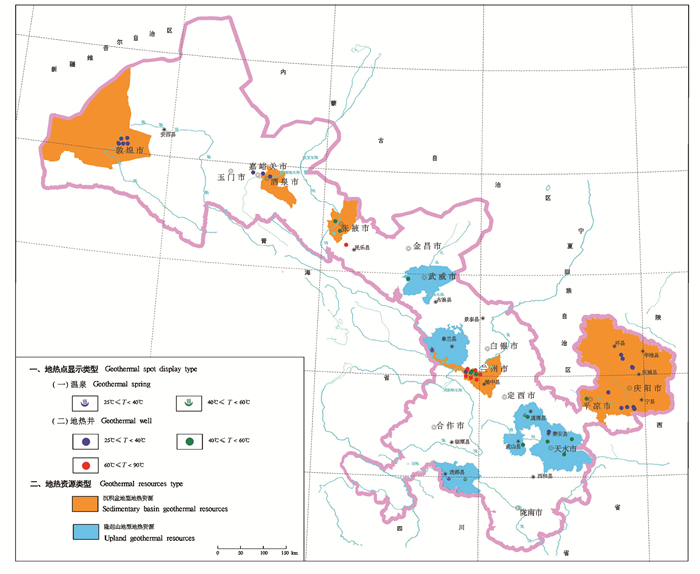
 下载:
下载:
